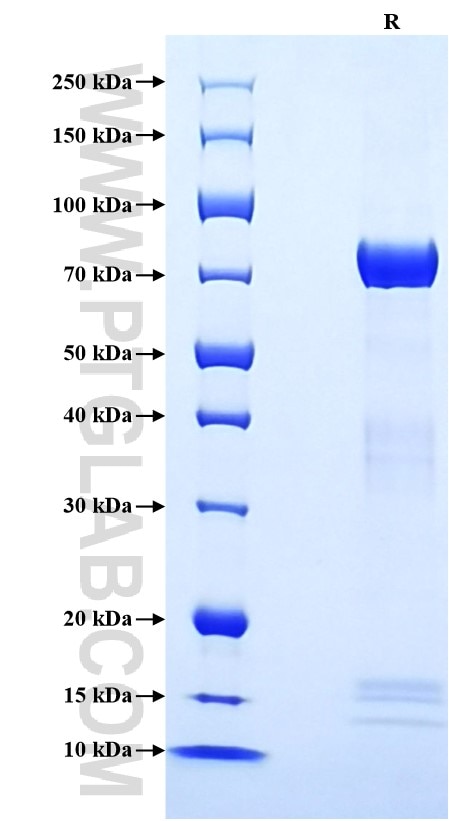Recombinant Human AGER/RAGE protein (rFc Tag)
Species
Human
Purity
>90 %, SDS-PAGE
Tag
rFc Tag
Activity
not tested
Cat no : Eg3860
Validation Data Gallery
Product Information
| Purity | >90 %, SDS-PAGE |
| Endotoxin | <0.1 EU/μg protein, LAL method |
| Activity |
Not tested |
| Expression | HEK293-derived Human AGER protein Ala23-Ala342 (Accession# Q15109-1) with a rabbit IgG Fc tag at the C-terminus. |
| GeneID | 177 |
| Accession | Q15109-1 |
| PredictedSize | 60.3 kDa |
| SDS-PAGE | 68-85 kDa, reducing (R) conditions |
| Formulation | Lyophilized from 0.22 μm filtered solution in PBS, pH 7.4. Normally 5% trehalose and 5% mannitol are added as protectants before lyophilization. |
| Reconstitution | Briefly centrifuge the tube before opening. Reconstitute at 0.1-0.5 mg/mL in sterile water. |
| Storage Conditions |
It is recommended that the protein be aliquoted for optimal storage. Avoid repeated freeze-thaw cycles.
|
| Shipping | The product is shipped at ambient temperature. Upon receipt, store it immediately at the recommended temperature. |
Background
AGER/RAGE is a multiligand receptor belonging to the immunoglobulin superfamily of cell surface receptors. It is highly expressed in inflammation-related pathological states and is associated with severe chronic pathologies, including diabetic complications, chronic inflammation, and cancer. Soluble forms of RAGE (sRAGE) are produced by proteolytic cleavage of full-length RAGE and alternative mRNA splicing. sRAGE can antagonize full-length RAGE and other receptors by binding DAMPs and other ligands, inhibiting leukocyte recruitment in various acute and chronic inflammatory conditions. sRAGE also has been identified as possessing therapeutic potential, as it can alleviate myocardial fibrosis and suppress autophagy and ischemia/reperfusion injury in rodent studies.
References:
1. Fritz G. (2011). Trends Biochem Sci 36(12):625-632. 2. Sparvero LJ. et al. (2009). J Transl Med 7:17. 3. Wang B. et al. (2024). Cardiovasc Drugs Ther.
